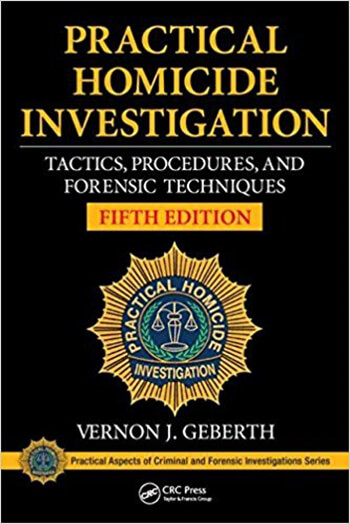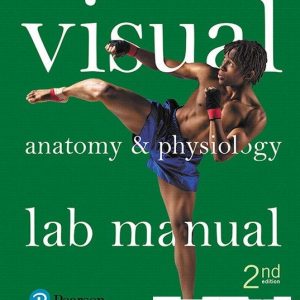Instant download Practical Homicide Investigation Tactics Procedures and Forensic Techniques 5th Geberth Test Bank pdf docx epub after payment.

Product details:
- ISBN-10 : 1482235072
- ISBN-13 : 978-1482235074
- Author: Vernon J. Geberth
Renowned for being THE definitive resource for homicide investigators, Practical Homicide Investigation: Tactics, Procedures, and Forensic Techniquesdetails the recognized protocols used by investigative divisions of major police departments throughout the world. The text is used in most police academies, including the FBI Academy in Quantico, Virginia. Now in its fifth edition, the book begins with a comprehensive discussion of homicide crime scenes and moves chronologically from initial police notification, the correct police response that follows, and the subsequent steps necessary to conduct an intelligent investigation. It then delves into the more technical aspects of homicide investigation, augmented with numerous pictures and full-color illustrations that involve pertinent case histories.
Table Of Contents:
The Homicide Crime Scene
The Five Components of Practical Homicide Investigation
The Crime Scene
The Preliminary Investigation at the Primary Crime Scene
Victimology
Equivocal Death Investigations
Most Common Errors or Missteps in Death Investigations
Conclusion
References
Selected Reading
First Officer’s Duties: General
Notification of a Possible Homicide: The Official Notification to the Police
First Notification of Homicide Received in Person by Patrol Officer
First Officer’s Duties on Arrival at the Scene
The First Officer Initiates the Homicide Investigation
Dealing with Emergencies at the Scene
Conclusion
Reference
Selected Reading
First Officer’s Duties: Specific
The Suspect in Custody
Transporting the Suspect
Examination of the Suspect for Evidence
The Dying Declaration
The Victim Removed to the Hospital
The Victim Pronounced DOA at the Hospital
The Officer’s Duties at the Hospital
The Victim Confirmed DOA at the Scene
Handling Witnesses at the Scene
Additional Officers at the Scene
Handling News Media Personnel at the Scene
The Documentation of Events by the First Officer
The Changing Sequence of Command
Patrol Officer’s Checklist
The Preliminary Investigation at the Scene: The Detectives
Initial Receipt of Information
Arrival at the Scene
Preliminary Steps to Be Taken by Detectives upon Arrival—Checklist
Describing the Scene
Implementing Crime Scene Procedures
Direction of Uniformed Personnel at the Scene
The Teamwork Approach
Directing the Investigation at the Scene
Duties of the Detective Supervisor on Arrival at the Scene
Preliminary Interview of the First Officer
Interview of Ambulance Personnel
Handling Curious Onlookers
Handling Witnesses at the Scene
The Canvass
The Preliminary Medical Examination at the Scene
Special Procedure to Follow in Specific Cases
Conclusion
Selected Reading
Specific Investigative Duties at the Scene
The Suspect in Custody
Interview and Interrogation of the Suspect in Custody
Examination of a Suspect for Evidence
Evaluation of the Suspect’s Demeanor and Mental Capacity
Homicide Calls and Statement Analysis
Obtaining a Dying Declaration
Handling Buried-Body Cases
The Investigative Checklist
References
Selected Readings
The Crime Scene Photographs
The Value of Crime Scene Photographs
Crime Scene Photography and the Investigator
Admissibility of Photographic Evidence
Photographing the Homicide Crime Scene
Type of Film
Recommended Crime Scene Photographs
Practical Application of Crime Scene Photography
Digital Video Recording
Conclusion
References
Selected Reading
The Crime Scene Sketch
The Sketch
Preparing the Crime Scene Sketch
Utilizing Aerial Photographs for Mapping Outdoor Crime Scenes
The Total Station Crime Scene Reconstruction Program
The Homicide Crime Scene Search
Legal Considerations
Physical Evidence
The Concept of Linkage
Methods of Crime Scene Search
Formulating the Search
The Homicide Kit
The Search
Examination of the Body at the Scene
Bloodstain Pattern Analysis
Documenting Bloodstain Patterns
Release of the Body
The Scene
Physical Examination of a Suspect in Custody
Release of the Scene
Crime Scene Process Protective Equipment and Clothing
Crime Scene Protocol for Protection from Airborne Pathogens and Other Biohazards
Exposure of First Responders
Exposure to Blood-Borne Diseases
Infection Control Techniques
Conclusion
References
Selected Readings
Estimating Time of Death
The Process of Dying
Body Changes after Death
External Agents of Change
Information Derived from the Scene
Conclusion
References
Selected Reading
The Identity of the Deceased; Resources for Missing and Unidentified Persons Cases
The Identification
Mass Fatality Events
The Iceman Case
The Teeth
The Bones
Forensic Art
Resources for Missing and Unidentified Persons Cases
Conclusion
References
Selected Readings
Death Notifications: The Surviving Family as Secondary Victims
Psychological Reactions to Death
The Normal Grieving Process
The Stages of Grief
Psychological Reactions to Murder
Psychological Reactions to Murdered Children
Psychological Reactions to the Murder of Police Officers
Notifications of Death by the Homicide Detective
Recommendations and Guidelines for Proper Death Notifications to Surviving Family Members
Providing Information to the Surviving Family
Guiding the Surviving Family through the Criminal Justice System
Conclusion
References
Selected Reading
Modes of Death
Gunshot Wounds
Cutting Wounds
Stabbing Wounds
Blunt Force Injuries
Deaths by Asphyxia
Deaths by Fire
Arson
Poisons
Deaths Caused by Injection
Sexual Asphyxia: The Phenomenon of Autoerotic Fatalities
References
Selected Reading
Suicide Investigation
Suicide Risk Factors
Depression: A Clinical Perspective
Other Motives for Suicide
The Investigation
Staging a Scene
Investigative Considerations
Chemical Suicides in Automobiles
Bizarre Suicides
Equivocal Death Investigations
Motives and Intent
Suicide Notes
Background Information
Psychological Autopsy
Final Exit Suicide Investigations
Suicide-by-Cop
Seven Major Mistakes in the Investigation of Suicide
Suicide Investigation Checklist Protocol
References
Selected Reading
The Investigation of Sex-Related Homicides
Introduction
The Crime Scene Investigation
Human Sexuality and Sexual Deviance
Paraphilic Disorders
Determining Motivation
Significance of Fantasy in Sex-Related Incidents
Technology and the Sex Offender
The Identification of the Victim
Modus Operandi and Signature
Organized and Disorganized Offenders
Four Classifications of Sex-Related Homicides
Interpersonal Violence-Oriented Disputes and Assaults
Rape- and/or Sodomy-Oriented Assault
Deviant-Oriented Assault—”The Lust Murder
The Serial Murder
Conclusion
References
Selected Readings
Homosexual Homicides
Introduction
Homosexual Relationships
Homosexual Lifestyles: Investigative Considerations
Interpersonal Violence-Oriented Disputes and Assaults
Murders Involving Forced Anal Rape and/or Sodomy
Lust Murders and Other Acts of Sexual Perversion
Homosexual Serial Murders
Investigative Assessment and Analysis of Case History
Investigative Significance
Psychological Considerations
Robbery-Homicide of Homosexuals
Homophobic Assault and “Gay-Bashing” Incidents
Conclusion
References
Selected Readings
Forensic Application of DNA Analysis: Introduction
An Introduction to Deoxyribonucleic Acid (DNA)
Cells: Structure and Molecular Biology
Structure and Function of DNA
Techniques and Procedures in Forensic DNA Analysis
Techniques and Procedures in Forensic DNA Analysis
Admissibility of DNA Evidence
Laboratory Accreditation
Relatedness Testing
Familial DNA Analysis
Touch DNA
Ancestry Determination
Forensic DNA Case Studies
Conclusion
References
Collection of Evidence
Procedures for Collection of Evidence
General Types of Evidence
Classifications of Physical Evidence
Collection of Specific Types of Evidence
References
Selected Readings
The Autopsy
The Medical Examiner/Coroner
Investigation of Death
Purpose of the Autopsy
The Medicolegal Autopsy
Human Anatomy
References
Selected Reading
The News Media in Homicide Investigations
The Changing Media Dynamic in the New Millennium
Establishing a News Media Policy
Homicide News Release Policy
Offering Rewards
Handling the News Media at the Scene
Preparing the News Release
Conclusion
Selected Reading
People also search:
|
practical homicide investigation tactics procedures and forensic techniques |





